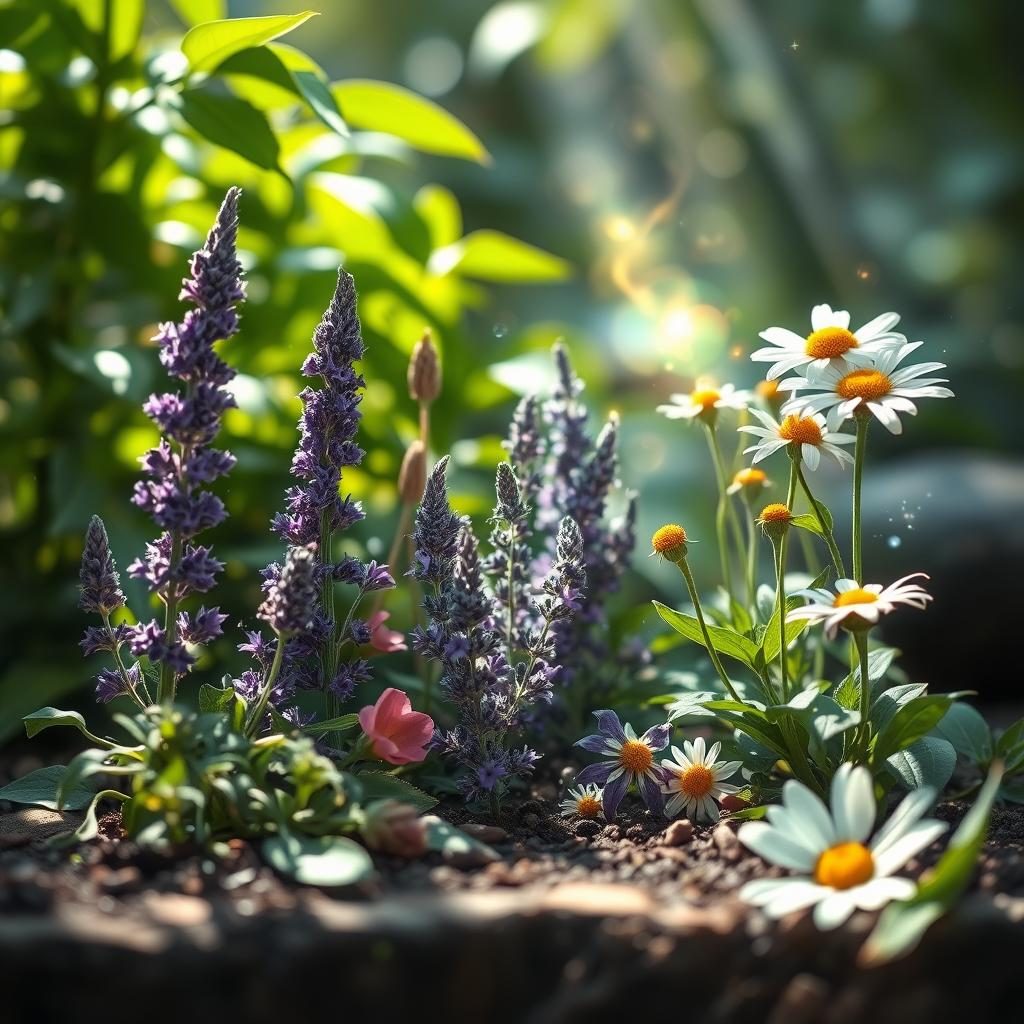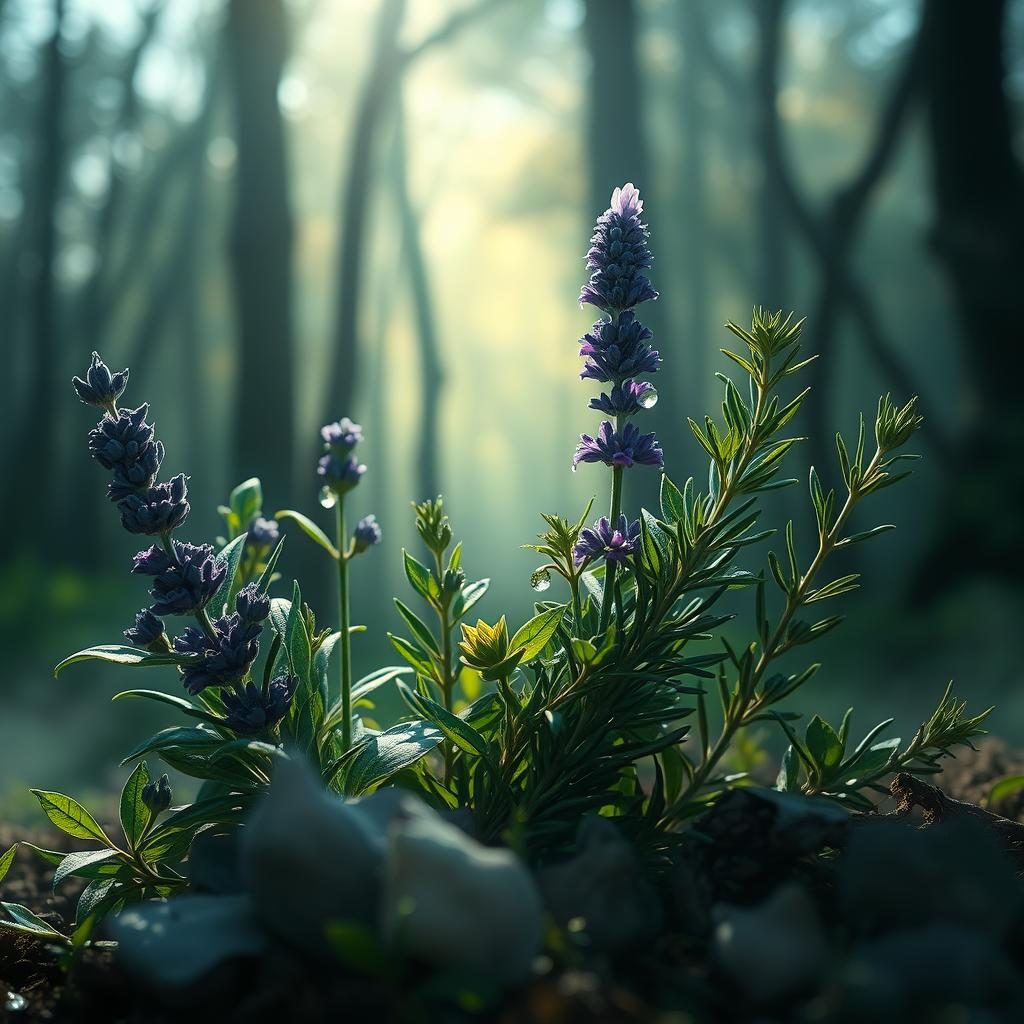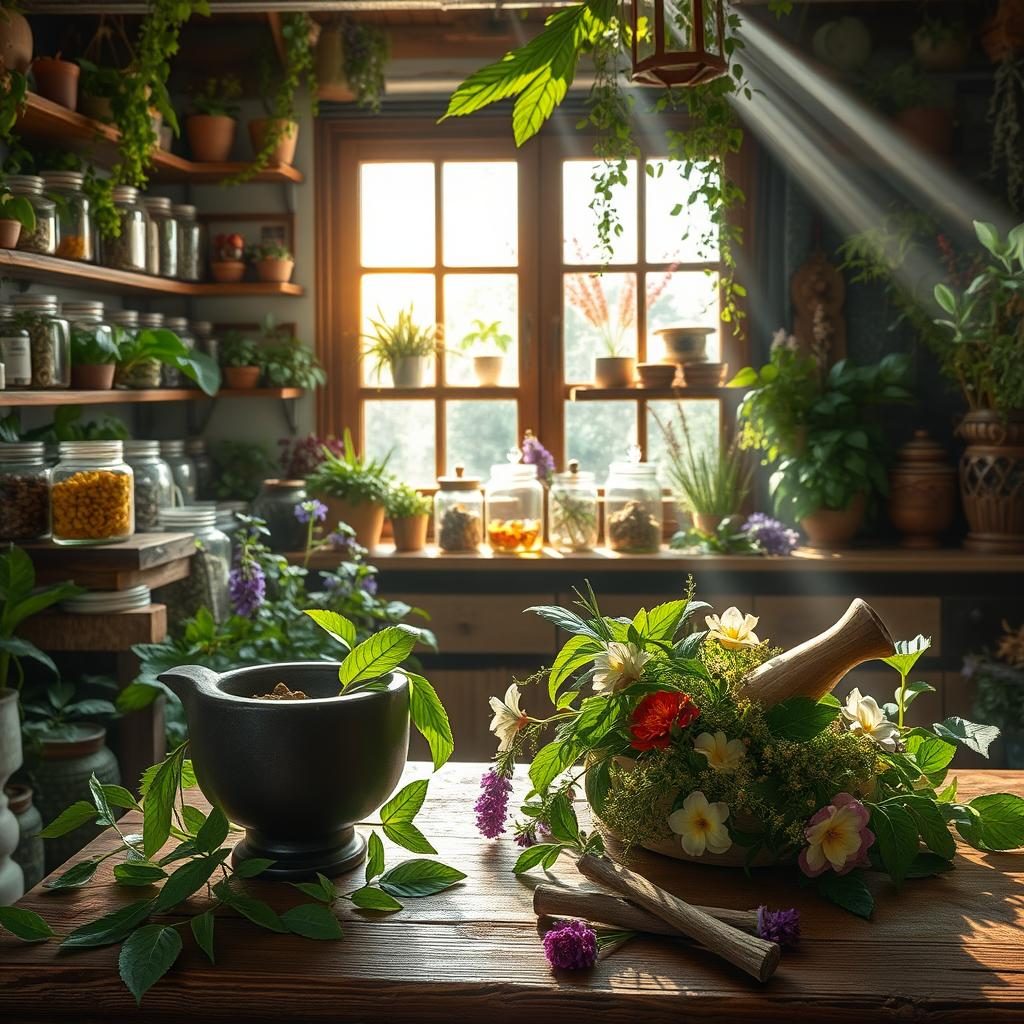“In every walk with nature one receives far more than he seeks.” – John Muir. This profound realization resonates deeply with me as I embark on my journey into the world of spiritual herbalism. The practice of utilizing healing plants stretches back through the corridors of time, rooted in ancient traditions and wisdom handed down from generation to generation. Engaging with the energy of plants not only offers us physical healing but can also nourish our spiritual realms. As we delve into this fascinating realm of plant medicine, we unearth not only the historical significance but also modern applications that enhance our overall well-being.
In this article, I plan to guide you through the myriad aspects of spiritual herbalism. From discovering the benefits of healing plants to exploring the sacred herbs and their uses, we will journey together in understanding how to connect with ancestral knowledge, develop holistic remedies, and even craft our own herbal apothecary. This immersive learning experience is designed to deepen our understanding of plant medicine in a way that resonates with our personal journeys.
Key Takeaways
- Spiritual herbalism is a practice rooted in ancient traditions.
- Healing plants offer both physical and spiritual benefits.
- Online courses and resources are available for those interested in learning.
- Creating personal connections with ancestral herbs can enhance well-being.
- Understanding plant communication is essential for spiritual growth.
- Building your own herbal apothecary can be a fulfilling endeavor.
Understanding Spiritual Herbalism
Spiritual herbalism embodies a unique blend of herbal practices that intertwine the medicinal and mystical properties of plants. I find it compelling that herbs carry their own intelligence and respond to their environment, teaching us profound lessons through their very essence. This approach broadens my understanding of herbal spirituality beyond merely a health tool. It illuminates a path towards an expansive spiritual journey, with the plant kingdom serving as a guiding light.
With over eight years of formal clinical herbal education, I’ve explored various methodologies. Some herbalists adopt a scientific view, while others embrace the spiritual realm. A significant number manage to combine both, enriching their practice and providing a holistic perspective. Contributions from both worlds allow a more profound exploration of herbs, resulting in a deeper comprehension of their effects. By studying the impact of spiritual imbalances on physical health, I realize the interconnectedness of my physical body, spirit, and soul.
Through comparative analysis, I have observed how different cultures experience the effects of herbs on both their physical and spiritual well-being. In many instances, the benefits derived from plants extend beyond what science can explain, showcasing the depth of herbal spirituality. This dual understanding helps me appreciate the intricate relationships that exist within the realms of healing.
I believe that holistic healing should incorporate physical, mental, emotional, and spiritual aspects for a more effective approach. Engaging with herbal spirituality is not merely about consuming remedies; it is about nurturing a connection with the plants and allowing them to guide my healing journey.
The Benefits of Healing Plants in Spiritual Herbalism
Healing plants offer a multitude of benefits, particularly in the realm of spiritual herbalism. This practice not only provides physical health benefits but also plays a vital role in emotional healing, enhancing overall well-being. I find it remarkable how specific herbal remedies can alleviate common ailments while fostering a connection to nature. For instance, chamomile is known for promoting calmness, while ginger aids digestion. Such plants are integral to holistic remedies that support body, mind, and spirit.
Physical Health Benefits of Herbal Remedies
Many people rely on herbal remedies for their physical health needs. Statistics suggest that 80% of the world’s population depends on herbs for basic healthcare requirements. With over 53,000 plant species utilized across various forms of herbalism, the diversity and accessibility of these healing plants prove invaluable. Commonly used herbs like cayenne pepper and garlic offer not only flavor but also medicinal properties that promote wellness. The marriage between traditional herbalism and modern practices creates a rich tapestry of holistic remedies that enhance our physical vitality.
Mental and Emotional Healing Through Plants
Engaging with healing plants can lead to profound emotional healing. The act of nurturing and interacting with these herbs fosters positivity and eases anxiety. Many therapeutic practices highlight the significance of reconnecting with nature, allowing for personal growth and transformation. Ancestral connections, such as the reverence for tulsi, illustrate how deeply intertwined our emotional and spiritual lives are with herbal wisdom. By incorporating these spiritual practices into daily routines, individuals can experience mental clarity and emotional stability, creating a harmonious balance in their lives.

Exploring Sacred Herbs and Their Uses
Engaging with sacred herbs can deepen spiritual practices, providing not only physical benefits but also enhancing emotional and spiritual well-being. These plants serve as a bridge between the physical and spiritual realms, emphasizing the importance of rituals and herbal recipes in daily life.
Common Sacred Herbs in Spiritual Practices
Numerous sacred herbs hold significant meaning in various spiritual traditions. Here are some prominent examples:
- Sage: Used for purification, sage is often burnt in rituals to cleanse spaces and individuals.
- Yarrow: Known for its protective qualities, yarrow is often included in herbal recipes for rituals aimed at safeguarding oneself.
- Verbena officinalis: This plant, revered for centuries, is known as the Enchanter’s herb, linked to various ancient civilizations.
- Poppy: Associated with the goddess Demeter, poppy is utilized to ease grief and suffering in spiritual practices.
- Henbane: Often linked with witchcraft, this herb contains substances that affect the central nervous system.
Rituals and Recipes Involving Sacred Herbs
Incorporating sacred herbs into my daily rituals enriches my spiritual journey. Here are a few simple herbal recipes and methods:
| Herb | Rituals | Herbal Recipes |
|---|---|---|
| Sage | Burn for space cleansing | Sage tea for relaxation |
| Yarrow | Protection rituals | Yarrow-infused oil for anointing |
| Verbena officinalis | Enhancing meditation | Herbal infusion for calmness |
| Poppy | Grief rituals | Poppy seed bread for nourishment |
| Henbane | Exploring consciousness | Henbane aromatic baths |
These practices and recipes can create a meaningful connection to the spiritual attributes of each sacred herb, allowing me to embrace their healing powers fully.

Connecting with Ancestral Knowledge
Exploring the depths of ancestral knowledge opens a fascinating dialogue between my personal history and the herbalism practiced by those before me. Ancestral herbs carry with them the wisdom of generations, serving as vessels of healing and understanding. As I delve into these time-honored traditions, I find it essential to comprehend the importance of maintaining a connection with these powerful plants and the communication they offer.
The Importance of Ancestral Herbs
Ancestral herbs play a vital role in my journey of healing and self-discovery. A substantial percentage of individuals recognize the significance of using plants that are familiar to their ancestors for emotional and mental healing. This realization not only reinforces my connection to cultural heritage but also demonstrates how intergenerational experiences shape our relationship with nature. Historical practices such as Ayurveda and Traditional Chinese Medicine initiated thousands of years ago emphasize the importance of these natural remedies in achieving balance and wellness.
How to Develop Relationships with Your Ancestral Herbs
Establishing deeper relationships with ancestral herbs requires intention and mindfulness. I often find that integrating practices from various traditions, such as those from Indigenous American tribes or Western European Herbalism, enhances my experience. Simple methods I can adopt include:
- Engaging in plant communication by spending quiet time with the herbs.
- Creating herbal preparations like tinctures and oils, with a ratio of 1 part rosemary to 1 part mugwort, allowing their combined properties to work synergistically over time.
- Using common aromatic herbs such as rosemary and sage to trigger the release of ancient knowledge during meditation.
- Allowing herbal oils to steep for at least two weeks or a full moon cycle, respecting the plants and their energies.

By embracing these practices, I develop a deeper understanding of my roots and the wisdom passed down through generations. The occurrence of individuals incorporating ancestral healing practices into their therapeutic approaches continues to rise, further confirming that our connection with these sacred plants is not just a personal journey, but a collective acknowledgment of healing through ancestral knowledge.
Introduction to Holistic Remedies and Plant Medicine
In my exploration of herbal spirituality, I have found that holistic remedies provide a comprehensive approach to healing. Unlike conventional medical practices that often treat symptoms in isolation, holistic herbalism views individuals as unique beings within a complex environment. This understanding enriches the significance of plant medicine, allowing it to address both physical and spiritual aspects of well-being.
Various traditions have long acknowledged the importance of these approaches. For instance, Traditional Chinese Medicine dates back centuries and incorporates around 5,000 remedies, emphasizing balance in body and spirit. Ayurvedic practices from India have leveraged the healing properties of herbs for nearly 5,000 years, showcasing the effectiveness of holistic methods.
As I delve deeper into the world of herbal remedies, I notice a distinct contrast between allopathic medicine, which often addresses isolated symptoms, and holistic approaches that seek to understand underlying causes. In holistic herbal practice, food serves as a healing agent, with the understanding that each person’s constitution is unique. The power of treatment is placed in the hands of individuals, aligning with the philosophy that wellness is a personal journey supported by nature.
The utilization of plant medicine offers an array of benefits, including safer alternatives to pharmaceuticals. This aspect resonates with me, especially considering the increasing concerns over the side effects associated with conventional medications. By integrating holistic remedies into daily life, I can tap into a wealth of traditional knowledge and practices passed down through generations.
The diversity of herbal products available today in the U.S. market demonstrates the growing interest in these holistic solutions. While this presents opportunities, it’s crucial to be aware of safety concerns regarding certain herbs. Adopting practices that prioritize ethical sourcing and sustainability is essential to making informed choices.
For those wishing to deepen their understanding, resources like the book Learn Spiritual Herbalism: Ancient Plant Wisdom serve as valuable guides in navigating the complex world of holistic remedies and plant medicine. Embracing this journey allows me to cultivate a more profound connection to nature and enhance my overall health through the wisdom of herbal spirituality.

| Aspect | Holistic Herbal Medicine | Allopathic Medicine |
|---|---|---|
| Treatment Philosophy | Addresses whole being; treats underlying causes | Treats symptoms; isolates body parts |
| Focus | Individual uniqueness and constitution | Standardized treatment methods |
| Source of Power | Individual empowerment | Medical professionals hold power |
| Natural Remedies | Milder, fewer side effects | Potent, strong medications |
| Speed of Care | Time-intensive, personalized care | Efficiency-driven, rapid care |
Spiritual Herbalism: An Immersive Learning Journey
For anyone looking to dive deeper into spiritual herbalism, there are a wealth of resources available that facilitate immersive learning. I have found several online courses and free resources to be invaluable in expanding my knowledge. These platforms offer a variety of formats, from video classes to interactive community experiences. Each resource is geared toward helping beginners understand the foundational concepts and practices of spiritual herbalism.
Online Courses and Free Resources for Beginners
Several online courses can launch your journey into spiritual herbalism. For example, The Green Arte School provides over 140 high-quality video classes centered on plant spirit paths and traditions. The expert behind this is Josh Williams, a clinical herbalist with more than 20 years of experience. He is also a candidate for Registered Herbalist with the American Herbalists Guild, enhancing the credibility of these courses. Additionally, his Patreon community offers monthly features like plant spirit journeys and audio meditations, making it easy to stay engaged and connect with others.
Here are some notable options to consider:
- The Green Arte School: Extensive online courses on various plant spirit practices.
- Remedies Herb Shop: Classes on topics ranging from immunity enhancement to women’s health.
- Free Zoom Info Session on spiritual herbalism scheduled for August 22nd, 2022, at 7 PM.
Books to Expand Your Knowledge of Spiritual Herbalism
Reading spiritual herbalism books provides deeper insights into the practices and philosophies associated with this field. Noteworthy titles include “Spiritual Herbalism” and “The Green Arte,” both authored by Josh Williams and published by Aeon in London. These texts serve as essential guides to understanding herbal spirit work. Other informative reads include “The Art & Practice of Spiritual Herbalism,” which discusses the body-system connections and the spiritual implications of herbal remedies.
Here’s a table summarizing some recommended spiritual herbalism books:
| Title | Author | Key Focus |
|---|---|---|
| Spiritual Herbalism | Josh Williams | Foundational concepts of herbalism and spiritual practices. |
| The Green Arte | Josh Williams | Plant spirit paths and traditions. |
| The Art & Practice of Spiritual Herbalism | N/A | Connection between body systems and spirituality in herbalism. |
| Ayurveda Medicine | N/A | In-depth look at over 250 herbs across various traditions. |
| Women’s Health and Herbal Remedies | N/A | Focus on menstrual health, fertility, and holistic wellness. |
Plant Communication: Deep Listening and Understanding
Engaging with plants goes beyond mere observation; it entails a deep communication that allows for a meaningful connection with the natural world. By cultivating an awareness of plant messages, I can unlock the wisdom hidden within herbal allies. This journey involves embracing intuition and developing a bond with plants that feels enriching and transformative.
Interpreting Plant Messages and Wisdom
Plant communication invites me to learn how to interpret the subtle clues that plants provide. As I engage with different herbs, I notice unique personalities and energies that resonate with my own. By practicing deep listening, I tap into their messages, enhancing my understanding of what they offer. Techniques like bringing gifts to plants, such as songs or nourishment, foster respect and open pathways for meaningful interactions. Spending quality time in nature helps solidify this connection and enhance my ability to perceive and understand plant messages.
Developing Intuition Through Nature
Tapping into intuition emerges as a vital aspect of deepening my nature connection. Various forms of communication, including energetic sensing and omens, play a significant role in developing this intuition. I appreciate the teachings from traditions that emphasize silence during communication with plants. This quietude permits me to embrace the innate ability to listen and feel what plants convey. Engaging in practices like daily meditation supports this journey, creating a safe space to cultivate awareness of the essential connections I share with plants.
Creating Your Own Herbal Apothecary
As I embark on my journey to create a personal herbal apothecary, I understand the importance of establishing a collection of herbs that will serve both my physical and spiritual needs. Starting with a few essential herbs, I find joy in learning about their unique properties and applications. For instance, Calendula (Calendula officinalis) stands out as a must-have for its skin healing benefits, while Chamomile (Matricaria recutita) offers soothing qualities for relaxation. By gradually introducing these herbs into my apothecary, I build a solid foundation of knowledge.
To enhance my herbal preparations, I also explore the wonders of Elderberry (Sambucus nigra) as a nutritious tonic for immune support. Additionally, Hibiscus (Hibiscus sabdariffa) presents a versatile option for crafting infusions, syrups, and even vinegars without the need for tincture-making. Each herb I choose serves a dual purpose—not only do I create natural remedies for myself, but I also deepen my connection to nature and my well-being.
With insights from experts like Mary Colvin, who has been a guiding light in clinical herbalism, I learn about the significance of sustainability in my practice. Her book, “The Herbalist’s Guide: How to Build and Use Your Own Apothecary,” serves as a vital resource, offering practical steps for building my herbal collection responsibly. As I cultivate my herbal apothecary, I remain committed to ethical harvesting and the conservation of medicinal plants, ensuring that my journey is enriching for both myself and the environment.







